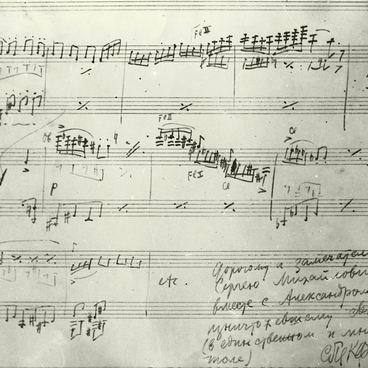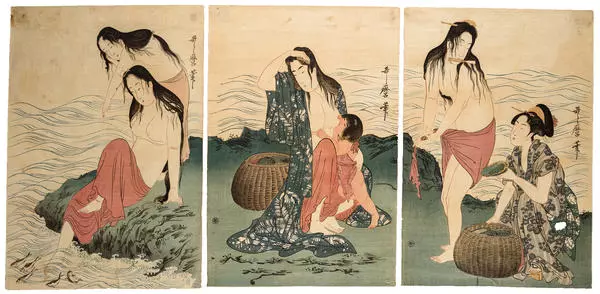The MAtsu HigashIya Teahouse wood engraving by UtamAro (1753–1806) hung in Eisenstein’s bedroom, on the same wall where he put another work by this artist, a triptych AwAbi Divers.
Sergei Eisenstein studied the works by Utamaro, a master of Japanese ukiyo-e print, very carefully in order to enrich cinematography with the techniques of the artist, who largely determined the features of Japanese classical engraving in its heyday period in the late 18th century.
Utamaro is referred to as an artist of feminine beauty and is widely known for the female characters of his most popular creations: geishas from the entertainment district of Yoshiwara, saleswomen, and tea housemaids. However, he also portrayed the life of ordinary artisans, landscapes, flora, and fauna of Japan. Utamaro was recognized as a classic of not only Japanese but also world culture for his characters' delicate state of mind, the elegance of line, and the extraordinary ingenuity of his compositions.
Kitagawa Utamaro was the first in Japanese xylography to use shoulder-length composition, combining multiple shapes on one sheet and masterfully using the white background of the paper, which played the color and light and shadow effects. These features of Utamaro’s art are visible in his engraving The Matsu Higashiya Tea House, created in 1795–1800. There is another version of this composition with some variations in the character’s clothing (different emblem on the shoulders) and an inscription on the pole saying “The Nakadaya Tea House.” Such a sheet is stored, inter alia, in the British Museum.
On the terrace of the Japanese house, there is a woman (probably a courtesan) with a teapot in her hand. However, a large shadow on the paper wall does not belong to her, as it seems at first glance, but to another courtesan, judging by her sophisticated hair. She sits in the house with a cup in her hand. Part of her face is barely visible behind a sliding screen door, and in the same slit one can see the face of another woman: apparently, a maid calling for the woman with the teapot. The Matsu Higashiya Tea House combines an everyday scene, a portrait and a landscape. The artist managed to fit three figures, part of the house and a branch of bushes into the composition at once, and the space still remains free.
Eisenstein learned the laconic means of expression and skillful use of space from Japanese masters. His scenes combine clear simplicity with dramatic tension. The distinctive feature of this print is that it is not physical figures, but the shadow of a courtesan that prevails in the presented action. In his film Ivan the Terrible, Sergei Eisenstein also played with shadows that sometimes seem to separate from Tsar Ivan and begin to act independently, commanding people.
Sergei Eisenstein studied the works by Utamaro, a master of Japanese ukiyo-e print, very carefully in order to enrich cinematography with the techniques of the artist, who largely determined the features of Japanese classical engraving in its heyday period in the late 18th century.
Utamaro is referred to as an artist of feminine beauty and is widely known for the female characters of his most popular creations: geishas from the entertainment district of Yoshiwara, saleswomen, and tea housemaids. However, he also portrayed the life of ordinary artisans, landscapes, flora, and fauna of Japan. Utamaro was recognized as a classic of not only Japanese but also world culture for his characters' delicate state of mind, the elegance of line, and the extraordinary ingenuity of his compositions.
Kitagawa Utamaro was the first in Japanese xylography to use shoulder-length composition, combining multiple shapes on one sheet and masterfully using the white background of the paper, which played the color and light and shadow effects. These features of Utamaro’s art are visible in his engraving The Matsu Higashiya Tea House, created in 1795–1800. There is another version of this composition with some variations in the character’s clothing (different emblem on the shoulders) and an inscription on the pole saying “The Nakadaya Tea House.” Such a sheet is stored, inter alia, in the British Museum.
On the terrace of the Japanese house, there is a woman (probably a courtesan) with a teapot in her hand. However, a large shadow on the paper wall does not belong to her, as it seems at first glance, but to another courtesan, judging by her sophisticated hair. She sits in the house with a cup in her hand. Part of her face is barely visible behind a sliding screen door, and in the same slit one can see the face of another woman: apparently, a maid calling for the woman with the teapot. The Matsu Higashiya Tea House combines an everyday scene, a portrait and a landscape. The artist managed to fit three figures, part of the house and a branch of bushes into the composition at once, and the space still remains free.
Eisenstein learned the laconic means of expression and skillful use of space from Japanese masters. His scenes combine clear simplicity with dramatic tension. The distinctive feature of this print is that it is not physical figures, but the shadow of a courtesan that prevails in the presented action. In his film Ivan the Terrible, Sergei Eisenstein also played with shadows that sometimes seem to separate from Tsar Ivan and begin to act independently, commanding people.





